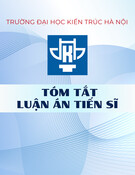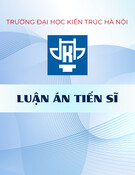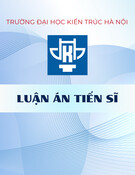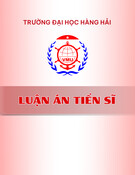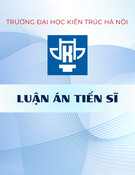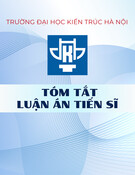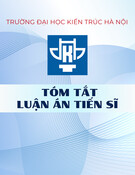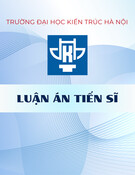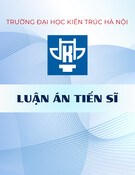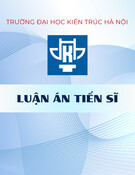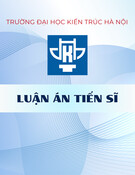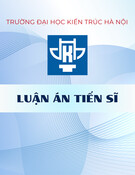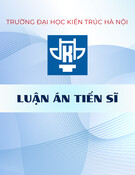
ĐẠI HỌC QUỐC GIA HÀ NỘI
KHOA QUẢN TRỊ VÀ KINH DOANH
---------------------
PHÙNG NGUYỄN MINH TÂM
CÂN BẰNG CÔNG VIỆC – CUỘC SỐNG
CỦA NHÂN VIÊN TRỤ SỞ CHÍNH AGRIBANK
WORK-LIFE BALANCE
OF AGRIBANK HEAD OFFICE STAFF
LUẬN VĂN THẠC SĨ QUẢN TRỊ KINH DOANH
HÀ NỘI - 2020

ĐẠI HỌC QUỐC GIA HÀ NỘI
KHOA QUẢN TRỊ VÀ KINH DOANH
---------------------
PHÙNG NGUYỄN MINH TÂM
CÂN BẰNG CÔNG VIỆC – CUỘC SỐNG
CỦA NHÂN VIÊN TRỤ SỞ CHÍNH AGRIBANK
WORK-LIFE BALANCE
OF AGRIBANK HEAD OFFICE STAFF
Chuyên ngành: Quản trị kinh doanh
Mã số: 8340101.01
LUẬN VĂN THẠC SĨ QUẢN TRỊ KINH DOANH
NGƯỜI HƯỚNG DẪN KHOA HỌC: TS. TRẦN HUY PHƯƠNG
HÀ NỘI - 2020

DECLARATION
The author confirms that the thesis's research outcomes result from the author's
independent work during the study and research period, and it is not yet published in
other's research and article.
The other's research results and documentation (extraction, table, figure, formula,
and another document) used in the thesis are correctly cited, and permission (if required) is
given.
The author is responsible for the Thesis Assessment Committee, Hanoi School of
Business and Management, and the laws for the declaration mentioned above.

CONTENT
INTRODUCTION ............................................................................................................... 1
1. Rationale ....................................................................................................................... 1
2. Research problem, research objective, and research question ................................ 1
3. Scope of the study ........................................................................................................ 4
4. Significance ................................................................................................................... 4
5. Structure of the thesis statements ............................................................................... 4
CHAPTER 1: LITERATURE REVIEW AND THEORETICAL MODEL .................. 6
1.1. Introduction ............................................................................................................... 6
1.2. Work-life balance concept ........................................................................................ 6
1.2.1. Work-life balance definitions ............................................................................ 6
1.2.2. Work-life balance benefits ................................................................................. 7
1.2.3. Work-life balance measurement ....................................................................... 8
1.2.4. Factors influencing work-life balance .............................................................. 9
1.3. Related empirical evidences ................................................................................... 12
1.4. Overview of Vietnamese banking system and Agribank .................................... 14
1.4.1. Overview of Vietnamese banking system ....................................................... 14
1.4.2. Overview of Agribank ...................................................................................... 16
1.5. Research model and research hypothesis ............................................................. 16
1.5. Conclusion ............................................................................................................... 19
CHAPTER 2: RESEARCH METHODOLOGY ............................................................ 20
2.1. Research methodology ............................................................................................ 20
2.2. Research design process ......................................................................................... 22
2.2..1. Questionnaire design ....................................................................................... 22
2.2.2. Sample ............................................................................................................... 25
2.2.3. Pilot study.......................................................................................................... 26
2.2.4. Data analysis ..................................................................................................... 26
2.3. Conclusion ............................................................................................................... 28
CHAPTER 3: DATA ANALYSIS AND FINDING ........................................................ 30
3.1. Introduction ............................................................................................................. 30
3.2. Frequency analysis .................................................................................................. 30
3.3. Descriptive statistics ............................................................................................... 34
3.4. Reliability test .......................................................................................................... 40

3.5. Explanatory factor analysis ................................................................................... 42
3.6. Independent sample t-test ...................................................................................... 46
3.7. One-way ANOVA ................................................................................................... 48
3.8. Linear regression .................................................................................................... 49
CHAPTER 4: DISUCSSION ............................................................................................ 51
4.1. Summary of key findings ....................................................................................... 51
4.2. Discussion ................................................................................................................ 52
4.3. Recommendation .................................................................................................... 54
CONCLUSION .................................................................................................................. 57
REFERENCES .................................................................................................................. 58
APPENDIX I: SURVEY OF QUESTIONNAIRE ............................................................ 1

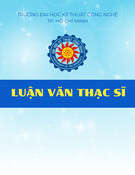


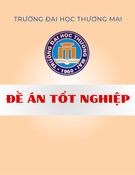


![Đề án Thạc sĩ: Đào tạo và phát triển nguồn nhân lực Viettel tại Đắk Lắk [mới nhất]](https://cdn.tailieu.vn/images/document/thumbnail/2025/20250710/rocky_06/135x160/89351752116141.jpg)



